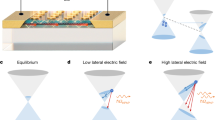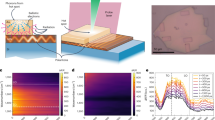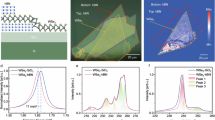Abstract
Under high electrical current, some materials can emit electromagnetic radiation beyond incandescence. This phenomenon, referred to as electroluminescence, leads to the efficient emission of visible photons and is the basis of domestic lighting devices (for example, light-emitting diodes)1,2. In principle, electroluminescence can lead to mid-infrared emission of confined light–matter excitations called phonon polaritons3,4, resulting from the coupling of photons with crystal lattice vibrations (optical phonons). In particular, phonon polaritons arising in the van der Waals crystal hexagonal boron nitride (hBN) present hyperbolic dispersion, which enhances light–matter coupling5,6. For this reason, electroluminescence of hyperbolic phonon polaritons (HPhPs) has been proposed as an explanation for the peculiar radiative energy transfer within hBN-encapsulated graphene transistors7,8. However, as HPhPs are locally confined, they are inaccessible in the far field, and as such, any hint of electroluminescence has been based on indirect electronic signatures and has yet to be confirmed by direct observation. Here we demonstrate far-field mid-infrared (wavelength approximately 6.5 μm) electroluminescence of HPhPs excited by strongly biased high-mobility graphene within a van der Waals heterostructure, and we quantify the associated radiative energy transfer through the material. The presence of HPhPs is revealed by far-field mid-infrared spectroscopy owing to their elastic scattering at discontinuities in the heterostructure. The resulting radiative flux is quantified by mid-infrared pyrometry of the substrate receiving the energy. This radiative energy transfer is also shown to be reduced in hBN with nanoscale inhomogeneities, demonstrating the central role of the electromagnetic environment in this process.
This is a preview of subscription content, access via your institution
Access options
Access Nature and 54 other Nature Portfolio journals
Get Nature+, our best-value online-access subscription
$32.99 / 30 days
cancel any time
Subscribe to this journal
Receive 51 print issues and online access
$199.00 per year
only $3.90 per issue
Buy this article
- Purchase on SpringerLink
- Instant access to full article PDF
Prices may be subject to local taxes which are calculated during checkout




Similar content being viewed by others
Data availability
Data are publicly available on Zenodo at https://doi.org/10.5281/zenodo.10625437 (ref. 38). Source data are provided with this paper.
Code availability
All codes are publicly available on Zenodo at https://doi.org/10.5281/zenodo.10625437 (ref. 38).
References
Akasaki, I. Nobel lecture: Fascinated journeys into blue light. Rev. Mod. Phys. 87, 1119 (2015).
Rosencher, E. & Vinter, B. Optoelectronics (Cambridge Univ. Press, 2002).
Kalt, H. & Klingshirn, C. Semiconductor Optics (Springer, 2019).
Low, T. et al. Polaritons in layered two-dimensional materials. Nat. Mater. 16, 182–194 (2017).
Dai, S. et al. Tunable phonon polaritons in atomically thin van der Waals crystals of boron nitride. Science 343, 1125–1129 (2014).
Dai, S. et al. Graphene on hexagonal boron nitride as a tunable hyperbolic metamaterial. Nat. Nanotechnol. 10, 682–686 (2015).
Yang, W. et al. A graphene Zener–Klein transistor cooled by a hyperbolic substrate. Nat. Nanotechnol. 13, 47–52 (2018).
Baudin, E., Voisin, C. & Plaçais, B. Hyperbolic phonon polariton electroluminescence as an electronic cooling pathway. Adv. Funct. Mater. 30, 1904783 (2020).
Li, J. et al. Single crystal growth of monoisotopic hexagonal boron nitride from a Fe-Cr flux. J. Mater. Chem. C 8, 9931–9935 (2020).
Messina, R., Ben-Abdallah, P., Guizal, B., Antezza, M. & Biehs, S. Hyperbolic waveguide for long-distance transport of near-field heat flux. Phys. Rev. B 94, 104301 (2016).
Shi, J., Liu, B., Li, P., Ng, L. & Shen, S. Near-field energy extraction with hyperbolic metamaterials. Nano Lett. 15, 1217–1221 (2015).
Shen, S., Narayanaswamy, A. & Chen, G. Surface phonon polaritons mediated energy transfer between nanoscale gaps. Nano Lett. 9, 2909–2913 (2009).
Tielrooij, K. et al. Out-of-plane heat transfer in van der Waals stacks through electron–hyperbolic phonon coupling. Nat. Nanotechnol. 13, 41–46 (2018).
Principi, A. et al. Super-Planckian electron cooling in a van der Waals stack. Phys. Rev. Lett. 118, 126804 (2017).
Pogna, E. A. et al. Hot-carrier cooling in high-quality graphene is intrinsically limited by optical phonons. ACS Nano 15, 11285–11295 (2021).
Maciel-Escudero, C., Konečná, A., Hillenbrand, R. & Aizpurua, J. Probing and steering bulk and surface phonon polaritons in uniaxial materials using fast electrons: hexagonal boron nitride. Phys. Rev. B 102, 115431 (2020).
Guo, Q. et al. Hyperbolic phonon-polariton electroluminescence in 2D heterostructures. Nature https://doi.org/10.1038/s41586-025-08686-9 (2025).
Schmitt, A. et al. Mesoscopic Klein–Schwinger effect in graphene. Nat. Phys. 19, 830–835 (2023).
Vandecasteele, N., Barreiro, A., Lazzeri, M., Bachtold, A. & Mauri, F. Current–voltage characteristics of graphene devices: interplay between Zener–Klein tunneling and defects. Phys. Rev. B 82, 045416 (2010).
Sadi, T., Radevici, I. & Oksanen, J. Thermophotonic cooling with light-emitting diodes. Nat. Photon. 14, 205–214 (2020).
Li, C. et al. Near-field and far-field thermal emission of an individual patch nanoantenna. Phys. Rev. Lett. 121, 243901 (2018).
Abou-Hamdan, L. et al. Hybrid modes in a single thermally excited asymmetric dimer antenna. Opt. Lett. 46, 981–984 (2021).
Abou-Hamdan, L. et al. Transition from phononic to geometrical mie modes measured in single subwavelength polar dielectric spheres. ACS Photon. 9, 2295–2303 (2022).
Gilburd, L. et al. Hexagonal boron nitride self-launches hyperbolic phonon polaritons. J. Phys. Chem. Lett. 8, 2158–2162 (2017).
Greffet, J., Bouchon, P., Brucoli, G. & Marquier, F. Light emission by nonequilibrium bodies: local Kirchhoff law. Phys. Rev. X 8, 021008 (2018).
Olsson, A. et al. Optical energy transfer and loss mechanisms in coupled intracavity light emitters. IEEE Trans. Electron Devices 63, 3567–3573 (2016).
Radevici, I., Tiira, J., Sadi, T. & Oksanen, J. Influence of photo-generated carriers on current spreading in double diode structures for electroluminescent cooling. Semicond. Sci. Technol. 33, 05LT01 (2018).
Taniguchi, T. & Watanabe, K. Synthesis of high-purity boron nitride single crystals under high pressure by using Ba-BN solvent. J. Cryst. Growth 2, 303 (2007).
Maestre, C. et al. From the synthesis of hBN crystals to their use as nanosheets in van der Waals heterostructures. 2D Mater. 9, 035008 (2022).
Roux, S. et al. Radiative lifetime of free excitons in hexagonal boron nitride. Phys. Rev. B 104, L161203 (2021).
Schmitt, A. et al. Electroluminescence of the graphene 2D semi-metal. Preprint at https://arxiv.org/abs/2306.05351 (2023).
Sapienza, R. et al. Long-tail statistics of the Purcell factor in disordered media driven by near-field interactions. Phys. Rev. Lett. 106, 163902 (2011).
Kim, W. et al. Thermal conductivity reduction and thermoelectric figure of merit increase by embedding nanoparticles in crystalline semiconductors. Phys. Rev. Lett. 96, 045901 (2006).
Poudel, B. et al. High-thermoelectric performance of nanostructured bismuth antimony telluride bulk alloys. Science 320, 634–638 (2008).
Pierret, A. et al. Dielectric permittivity, conductivity and breakdown field of hexagonal boron nitride. Mater. Res. Express 9, 065901 (2022).
Schmitt, A. et al. High-field 1/f noise in hBN-encapsulated graphene transistors. Phys. Rev. B 107, L161104 (2023).
Hugonin, J. & Lalanne, P. RETICOLO software for grating analysis. Preprint at https://arxiv.org/abs/2101.00901 (2021).
Abou-Hamdan, L. et al. Observation of electroluminescence and energy transfer of hyperbolic polaritons. Zenodo https://doi.org/10.5281/zenodo.10625437 (2024).
Acknowledgements
The research leading to these results has received partial funding from the European Union Horizon 2020 research and innovation programme under grant agreement number 881603 ‘Graphene Core 3’, and from the French ANR-21-CE24-0025-01 ‘ELuSeM’. This work has received support under the programme ‘Investissements d’Avenir’ launched by the French Government. J.H.E. and E.J. appreciate support for monoisotopic hBN crystal growth from the US Office of Naval Research under award number N00014-22-1-2582. We thank R. Pierrat and R. Carminati for their scientific insights; and L. Tailpied and B. Fix for supplemental scattering-scanning near-field optical microscopy characterizations.
Author information
Authors and Affiliations
Contributions
L.A.H., A.S., B.P., Y.D.W. and E. Baudin conceived the experiments. A.S. conducted device fabrication and electrical measurements under the guidance of D.M., A.P. and M.R. in the early developments. T.T., K.W., C.M., C.J., B.T., V.G., P.S., J.H.E. and E.J. provided the hBN crystals. L.A.H. and S.R. performed the mid-infrared emission measurements with the help of A.S. and R.B. A.S. performed the Raman thermometry measurements. M.T. performed the near-infrared measurements. J.-P.H., J.-J.G., E. Bailly, B.V., L.A.H. and E. Baudin performed the numerical simulations. L.A.H., A.S., R.B., S.R., J.-J.G., E. Bailly, B.V., Y.D.W., C.V., B.P., J.-M.B., G.F., P.B., G.M. and E. Baudin analysed the data and developed the theoretical interpretation. J.-P.H. wrote the numerical codes. L.A.H., A.S., R.B., Y.D.W. and E. Baudin wrote the paper with contributions from the co-authors.
Corresponding author
Ethics declarations
Competing interests
The authors declare no competing interests.
Peer review
Peer review information
Nature thanks Pablo Alonso-González, Stefan Rotter and the other, anonymous, reviewer(s) for their contribution to the peer review of this work. Peer reviewer reports are available.
Additional information
Publisher’s note Springer Nature remains neutral with regard to jurisdictional claims in published maps and institutional affiliations.
Extended data figures and tables
Extended Data Fig. 1 Optical microscope images of transistors TR1 (left) and TR2 (right).
Resolved with a ×50 objective.
Extended Data Fig. 2 Schematic illustration of the mid-infrared pyrometric technique.
The technique uses optical chopping to detect the spectrally integrated signal (PMIR, integrated over the full spectral range of the detector) of an hBN-encapsulated graphene device (left, TR2 device with L × W = 35 × 35 μm2) due to the radiative emission of the SiO2 backgate. The setup was utilized to perform the pyrometric characterization of Fig. 3.
Extended Data Fig. 3 Spectral response function (r) of the mid-IR setup for the two detection techniques utilized in this study.
a, Spectral response function for modulation with an optical chopper. b, Spectral response function of the infrared spatial modulation spectroscopy (IR-SMS) technique.
Extended Data Fig. 4 Calibration of the pyrometric technique.
a, Comparison between the mid-IR spectra of the hBN-encapsulated device TR2 with an SiO2 backgate under electrical bias and by heating the device via a hot plate at various temperatures T. The mid-IR signal is measured using an optical chopper (see Extended Data Fig. 2). The plotted spectra are corrected by a reference measurement, which removes the contribution of the chopper to the detected signal, and then normalized by an instrumental response function (see supplementary information of ref. 31). b, Linear fit of the spectrally integrated signal Sint obtained with the hot plate as a function of temperature. Sint is found by integrating the spectra S from panel a over the detector’s spectral bandwidth. From the comparison of panel a we find that the temperature of the SiO2 backgate varies between \(\Delta {T}_{{{\rm{SiO}}}_{2}}\simeq 0-40\,^\circ {\rm{C}}\) when the device is electrically biased. c, Scan of the mid-IR spectrally-integrated power PMIR emitted by the TR2 device as a function of bias. d, Increase in the temperature of the device’s SiO2 backgate (\(\Delta {T}_{{{\rm{SiO}}}_{2}}\)) as a function of electrical bias, obtained from the mid-IR signal-to-sample temperature calibration.
Extended Data Fig. 5 Raman Stokes-anti-Stokes (SAS) thermometry of the TR1 device.
The temperature of hBN’s optical phonons measured by SAS thermometry (see Methods) is plotted as a function of bias for three different dopings (Vg = 1.5 V corresponding to charge neutrality). At charge neutrality, the temperature of hBN’s optical phonons is found to be ≲75 °C.
Extended Data Fig. 6 Electroluminescence vs hBN’s incandescence.
Comparison between the IR-SMS spectral flux of TR1 under electrical bias (red curve) and its incandescence when heated via a hot plate to the temperature of hBN’s optical phonons (~75 °C, green curve). This comparison reveals that the main polariton peak at ~190 meV, which is involved in the electroluminescence process, is notably absent from the thermal emission spectrum (green curve). Thus, incandescence from hBN’s optical phonons can be dismissed as the origin of the mid-IR signal.
Extended Data Fig. 7 Electroluminescence versus graphene’s hot electron incandescence.
a, Sweep of the mid-infrared spectral emission of the TR1 device (inset) under electrical bias, measured via IR-SMS. b, Spectral flux at the HPhP resonance, marked by an asterisk in panel a, as a function of applied bias. Both experiments were performed at Vg = 0 V. The hollow grey triangles are the Planck law fit given by \(A{E}^{3}\,/[\exp (E\,/{k}_{B}{T}_{e})-1]\), in which A is a fitting constant, E = 192 meV is the polariton energy, and Te is the electron temperature given in Extended Data Table 2. A is determined by equating the spectral flux at Vds = 4.3 V to the value of the measured spectral flux at the same point. The magenta and grey curves are a second-order polynomial fit and a linear fit, respectively, corresponding to the data points. The inset shows the ratio of the measured spectral flux to that obtained from the Planck law fit. The measured spectral flux with increasing bias is about two times larger than that expected from incandescence in the bias range 6−8 V, thus precluding graphene’s incandescence as a possible source of the measured signal. Note that this fitting procedure represents a worst-case scenario, in which it is assumed that the measured mid-IR flux at a low value of bias (4.3 V) is equal to that of the incandescence flux and the evolution of the two fluxes is compared as a function of increasing bias.
Extended Data Fig. 8 Electroluminescence of device TR3 with scatterers exhibiting a peak around 800 cm−1 in hBN’s first Reststrahlen band.
a, Optical microscope image of the electroluminescent HPHT-hBN device TR3 resolved with a ×100 objective. The device includes scatterers in the form of subwavelength gold disks and etches in the hBN layer that are randomly distributed across the device’s channel. b, Mid-IR spectrum of TR3 under bias (Vds = 13 V, Vg = 0 V) measured via IR-SMS.
Extended Data Fig. 9 Electroluminescence of device TR4 without scatterers exhibiting a peak around 190 meV in hBN’s second Reststrahlen band.
a, Optical microscope image of the electroluminescent HPHT-hBN device TR4 resolved with a ×50 objective. Notably, the device does not include scatterers in the form of subwavelength gold disks. Thus, only the metallic contacts can scatter HPhPs and the short channel length further enhances this effect. b, Mid-IR spectrum of TR4 at zero gate voltage and variable drain-souce bias (Vds) measured via IR-SMS.
Extended Data Fig. 10 Comparison of the differential reflectance peaks of hBN flakes of various crystalline quality.
a, Reflectance difference in the mid-IR between the reflectance spectra of hBN flakes on a diamond substrate and the reflectance spectra of a diamond reference for two different HPHT-hBN flakes labelled NIMS and two different PDC-hBN flakes labeled Lyon. The signal is proportional to the absorptance with an amplitude that scales with the flake thickness. b,c, Bar plots comparing the absorption peak centre energy (b) and linewidth (c), fitted by a Lorentzian function from the differential reflectance of the 4 samples studied here. Measurements were performed with a Cassegrain objective with ×15 magnification, a numerical aperture of 0.4, and a Brüker Hyperion spectrometer. The spectral resolution is 2 cm−1.
Extended Data Fig. 11 Electronic noise temperature (TN) as a function of bias for 3 graphene transistors each made with a different type of hBN crystal.
HPHT-hBN from NIMS, PDC-hBN from Lyon and APHT mono-isotopic h11BN from KSU. a, Electronic noise temperature of a device made with mono-isotopic boron nitride from KSU, USA (>99% 11B, fabricated at high temperature and atmospheric pressure). b, Electronic noise temperature of a device made with HPHT-hBN from NIMS, Japan. c, Electronic noise temperature of a device made with PDC-hBN from Lyon, France. While the Zener tunnelling regime leads to reduced electronic heating for both APHT- and HPHT-hBN at large bias, there is no such signature in PDC-hBN, confirming that radiative energy transfer is significantly reduced in this material.
Supplementary information
Source data
Rights and permissions
Springer Nature or its licensor (e.g. a society or other partner) holds exclusive rights to this article under a publishing agreement with the author(s) or other rightsholder(s); author self-archiving of the accepted manuscript version of this article is solely governed by the terms of such publishing agreement and applicable law.
About this article
Cite this article
Abou-Hamdan, L., Schmitt, A., Bretel, R. et al. Electroluminescence and energy transfer mediated by hyperbolic polaritons. Nature 639, 909–914 (2025). https://doi.org/10.1038/s41586-025-08627-6
Received:
Accepted:
Published:
Issue date:
DOI: https://doi.org/10.1038/s41586-025-08627-6



